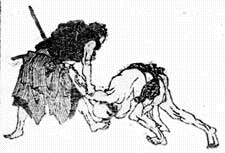Originally posted in:

 In a recent thread in the forum section, a poster delightedly quoted the wisdom of Isoyama Sensei regarding hakama, that "Until Shodan, must to see feet. After Shodan, no need to see feet." With all due respect, I can only wish that Isoyama Sensei did not make this statement because it illustrates a surprising lack of knowledge of Japanese history. Hakama are, essentially, riding culottes. Ordinary Japanese clothing was quite simple: men wore a fundoshi (loin cloth) and kimono, women a kimono with no undergarments. Horseriders (males, for women rode side-saddle, if at all) would be flashing "that which made them most mister" without a hakama to prevent them so flying the flag. In addition, unlike commoners, it would surely be considered unseemly for a bushi to flash his genitals or buttocks in any situation, including training. This was particularly true for women training in any athletic or martial pursuit.
In a recent thread in the forum section, a poster delightedly quoted the wisdom of Isoyama Sensei regarding hakama, that "Until Shodan, must to see feet. After Shodan, no need to see feet." With all due respect, I can only wish that Isoyama Sensei did not make this statement because it illustrates a surprising lack of knowledge of Japanese history. Hakama are, essentially, riding culottes. Ordinary Japanese clothing was quite simple: men wore a fundoshi (loin cloth) and kimono, women a kimono with no undergarments. Horseriders (males, for women rode side-saddle, if at all) would be flashing "that which made them most mister" without a hakama to prevent them so flying the flag. In addition, unlike commoners, it would surely be considered unseemly for a bushi to flash his genitals or buttocks in any situation, including training. This was particularly true for women training in any athletic or martial pursuit. There were formal hakama in which the hem covered the feet. Not being a researcher, I do not know all the reasons for this: among those claimed are that this restricted feet movements, making it more difficult to attack the daimyo in his palace. It may merely have been that nobility always becomes decadent, and this includes their clothing. Another example would be the absurd long-pointed slippers so popular in Europe at one point, the Freudian associations here all too easy to make.
 Nonetheless, the hakama was usually meant to be functional. Too long a hem, and it would cover and tangle with the stirrups. Just as bad, the streets of medieval Japan, like those of Europe, were filthy. Too long a hem and the bushi would be trailing manure and other filth into the mansions and palaces where he worked. Thus, a hakama properly should never descend below ankle height. Not only should you ALWAYS be able to see the feet, but the ankles and perhaps even a little shin as well.
Nonetheless, the hakama was usually meant to be functional. Too long a hem, and it would cover and tangle with the stirrups. Just as bad, the streets of medieval Japan, like those of Europe, were filthy. Too long a hem and the bushi would be trailing manure and other filth into the mansions and palaces where he worked. Thus, a hakama properly should never descend below ankle height. Not only should you ALWAYS be able to see the feet, but the ankles and perhaps even a little shin as well.It somehow became a fashion within some aikido circles to wear a long hakama which covers the feet. Look at old pictures of O-Sensei, and you will find them as unfashionably short as John Stockton's tight little basketball shorts in an era of hip-hop style "baggies." That one so eminent as Isoyama Sensei is apparently unaware of this (and not merely scoring points on another, younger instructor who has students wear hakama from the first day) is surprising to me in one respect, but I have found aikidoka of every level, Japanese and foreign, quite unaware of their own cultural roots.
I must confess that even I was once so blind (yet now I see). When I got my shodan, I proudly bought, special-order, the longest hakama in the history of the Suidobashi budoya (can't remember the name). I went to Masuda Sensei's class, proudly planted myself in a broad seiza, front and center, so he'd see and call me out for the first technique. He comes in, says, "Oh, new shodan," and happily beckoned to me. Like a tiger, I leapt at him, and my toe catching in the hem, flew horizontally to do a face-plant right at his feet. He and 80 other people in the class were laughing so hard they were crying, and Masuda waved me away without a throw, still speechless with laughter. So truly, with all due respect to Isoyama Sensei, even after shodan, still "need to see feet."
This article was originally written by Ellis Amdur for the Aikido Journal and was used with permission.
Posted by kroh1
at 1:00 PM EST
Updated: Wednesday, 22 February 2006 1:10 PM EST

